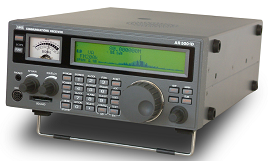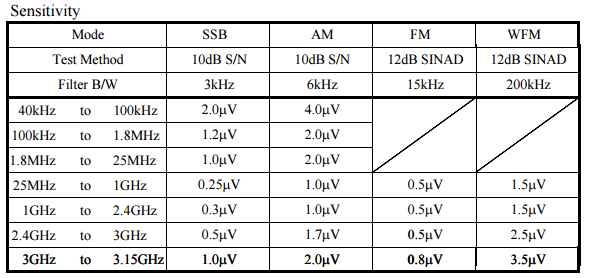AR5001D Receptor 40kHz ~ 3.15GHz,
AOR
Em breve traducão em Português (BR).
Super wide range
Continuous frequency coverage: 40 kHz to 3.15 GHz in 1 Hz step with 1ppm frequency accuracy. (Frequency accuracy can be optimized to 0.01ppm with an optional GPS receiver.)
Multi-Mode reception
High performance digital signal processing circuitry offers variety of reception modes as well decoding options. Receiving mode includes USB/LSB, CW, AM, SAM, FM, Wide FM and FM stereo. The decoding modes include CTCSS, DCS, DTMF and APCO P-25 by an optional P-25 decoder.
High-Performance analog front-end
The RF frond-end is carefully designed by CAD to optimum performance across the entire frequency range of 40 kHz to 3.15 GHz.
Direct Sampling Architecture (40 kHz - 25 MHz)
The AR-5001D employs 14bit/65Ms/s direct sampling receiver architecture for VLF, LF and HF band. The direct sampling architecture assures high IMD and IP3 characteristics.
Digital Signal Processing
The 45.05MHz IF signal is processed by the independent signal processor for signal demodulation and recovery. No AGC circuitry is used in the analog stage to ensure accurate level reading as well as to offer IF output signal linearity against RF input signal.
FFT Signal Analyzer
The AR-5001D employs FFT(Fast Fourier Transform) signal analyzer that displays 400 kHz to 10 MHz in 100 kHz increment of spectrum to monitor the band activity or detect unidentified signal instantaneously.
Wideband IF output (25 MHz to 3.15 GHz)
A 45.05 MHz of IF analog output signal with 15 MHz bandwidth is provided for external peripherals when using the AR-5001D receiver for front-end. The optional I/Q output board with USB2.0 interface is available to access AR-5001D`s I/Q data for spectrum recording and playback by a PC.
High accuracy reference frequency
The AR-5001D is capable of using GPS pulse signal for an accurate time base for the local oscillator circuit. 0.01ppm frequency accuracy for the 10 MHz internal master oscillator is obtained when synchronized to a GPS signal.


Simultaneous reception and monitoring
Simultaneous reception on HF (below 25 MHz) and VHF-UHF (above 25MHz) frequencies are possible. For frequencies above 25 MHz, absolute dual-channel reception within 5 MHz is possible. Thus, up to three channels can be monitored simultaneously.
Direct digital synthesizer (DDS) local oscillator
Direct digital synthesizer is employed for the 1st local oscillator that ensures fast frequency switching for memory channel scanning and limited band search operation.
SD Audio recorder
AR-5001D is capable of recording demodulated audio signal directly to the built-in SD media recorder. Compact and readily available, SD memory cards are immune to vibrations and produce no mechanical noise, unlike motor-driven media such as tapes or discs.
The AR-5001D can accommodate up to 32GB SDHC card, allowing up to 240 hours of total recording time using PC compatible WAY format. The typical continuous recording time with 1 GB SD card is about 8 hours. The recording time can be extended when sque1ch operation is employed.
Analogue VIDEO demodulation
Composite video output is provided to monitor FM modulated analogue type wireless security camera or frequency search operation for bug transmitter.
Optional APCO P-25 Digital Voice Decoder
APCO P-25 Digital Voice Decoder option is available for the demodulation of project 25 (P25) digital voice communication which are popular in North American for the government and public safety communications.
AF-IQ Output
A 12kHz IF output is provided for a PC sound card based SDR (software defined radio) for signal demodulation by the PC. Typical application includes the reception of DRM (Digital Radio Mondiale) broadcasts on HF frequencies.
Optional Digital I/Q board and PC software
When an optional I/Q interface board is installed, up to 1 MHz of digital I/Q output can be recorded to the hard drive of computers operating under Windows environment for later playback and analysis without any loss of quality. This feature allows for unattended logging, signal classification and signal analysis PC control software for Windows XP, VISTA and 7 is supplied with the board.

Em breve traducão em Português (BR).
GENERAL
|
Frequency range |
40 kHz to 3.15 GHz |
|
Frequency resolution |
1Hz |
|
Tuning steps – program |
1Hz to 999.999 kHz in 0.001 kHz increments |
|
Receiving mode |
USB/LSB(J3E), CW(A1A), AM(A3E), SAM(A3E), FM(F3E), WFM(F3E), FM-Stereo(F8E), APCO P-25(D3E) Optional |
|
Number of VFO |
5 (A through E) |
|
Memory channel |
2,000 channels (50 channels x 40 Memory banks) |
|
Memory bank |
40 banks (each bank can be customized between 5 to 95 channels) |
|
Pass frequencies |
1,200 frequencies or 1,200 frequency ranges 30 frequencies (ranges) x 40 banks |
|
Priority channel |
1 (one) |
|
Selected memory channel |
100 channels through memory banks |
|
Typical Scanning speed |
Approx. 100 channels/steps per second |
|
Antenna impedance |
50Ω |
|
Operating temperature range |
0°C to +50°C / 32°F to 122°F |
|
Frequency stability |
Less than 1 ppm after warm-up (5 minutes). Less than 0.01 ppm with optional GPS unit. |
|
Power supply requirement |
DC 10.7V to 16V, 2,0A @ 12V. |
|
Audio Output |
>> 2W into 8Ω load. |
|
Power consumption |
Stand-by: 400mA, Max Audio: 1.5A |
|
Grand system |
Negative ground. |
|
Dimensions |
304 (D) x 220 (W) x 97 (H) mm |
|
Weight |
5kg (1.1 lb) |
RECEIVER
|
Receiver system |
40kHz – 25MHz Direct conversation 25MHz – 220MHz Double super-heterodyne 220MHz – 360MHz Triple super-heterodyne 360MHz – 3.15GHz Double super-heterodyne |
|
Intermediate frequencies |
1st - 294.5MHz / 1.7045GHz 2nd- 45.05MHz / 294.5MHz 3rd- 45.05MHz |
|
Third-order IMD |
>+20 dBm at 14.1MHz >+9 dBm at 50MHz >+5 dBm at 620MHz |
|
Spurious and image rejection |
>70 dB: 40kHz – 25MHz >50 dB: 25MHz – 2GHz >40 dB: 2.0GHz – 3.15GHz |
|
Digital IF filter bandwidth |
200Hz, 500Hz, 1kHz, 3kHz, 6kHz, 15kHz, 30kHz, 100kHz, 200kHz – Receiving mode dependence. |
|
Selectivity |
CW – 500Hz -3dB: > 380Hz -80dB: > 500Hz AM – 6kHz -3dB: > 5.5kHz -80dB: >6.9kHz SSB – 3kHz -3dB: > 2.7kHz -80dB: > 3.1kHz NFM – 15kHz -3dB: > 14.2kHz -80dB: > 15.6kHz WFM – 200kHz -3dB: > 200kHz -80dB: > 250kHz |

AUXILIARY FUNCTIONS
|
Simultaneous reception |
Two types of simultaneous reception (dual-watch) are possible. |
|
2 band reception |
One HF (40kHz – 25MHz) frequency plus one VHF/UHF (25MHz and above) frequency. |
|
Offset reception |
Main frequency plus sub-frequency (within 5MHz from the center frequency) Offset reception is possible only for VHF/UHF |
|
Triple reception |
Triple reception are possible by combing simultaneous reception modes. I.E. One HF frequency plus offset reception. |
|
Squelch system |
CTCSS, DCS |
|
Demodulation Aid |
Auto notch filter (NOTCH), de-noiser (NR), Noise blanker, IF Shift, CW Pitch, AGC, AFC, DTMF, APCO P-25 Digital voice decoder (option) |
AUDIO RECORDING
|
Type of recording |
Record/playback function through SD or SDHC |
|
SD Card type |
SD or SDHC card per SD Card Association more than 256MB is required. Use card adapter for miniSD and microSD cards. FAT16 and 32 only. |
|
File format |
Windows compatible WAV file format. RIFF (little-endian) data, WAVE audio, Microsoft PCM, 16-bit mono 17.578kHz |
|
Recording time |
Approximately 8 hours of continuous recording by 1GB SD card. Squelch synchronization is possible to eliminate inactive time. |
INPUT & OUTPUT
|
Antenna Input |
ANT 1: 25MHz – 3.15GHz, N-J connector ANT 2: 40KHz – 3.15GHz, N-J connector |
|
10MHz reference input |
SMA-J connector, Typical input: -2dB±2dBm for 50Ω |
|
45.05MHz Analog IF output |
BNC-J connector, 45.05MHz±7.5MHz Typical output: antenna input +10dBm for 50Ω Frequency range 25MHz – 3.15GHz only |
|
Digital I/Q output (Option) |
USB2.0 compatible isochronous transfer Digital I/Q output through USB type-A jack Frequency range 25MHz – 3.15GHz only |
|
12kHz offset output |
12kHz offset analog I/Q through 3.5mm stereo-phone jack. |
|
Line output |
3.5mm stereo-phone jack (3-wire) |
|
Accessory |
8-pin miniature DIN |
|
DC Power input |
EIAJ MP-121C (5.5 x 2.1mm) plug. Positive center. |
|
External speaker |
3.5mm miniature phone jack (2-wire) |
|
RS-232C |
9-pin D-subminiature type (male) – Firmware update and remote control by PC. |
|
USB |
USB Type-A; USB 1.1/2.0 Jack for PC control. |
|
VIDEO output (Rear Panel) |
RCA Jack, 75Ω 1V p-p |







 Brochure
Brochure